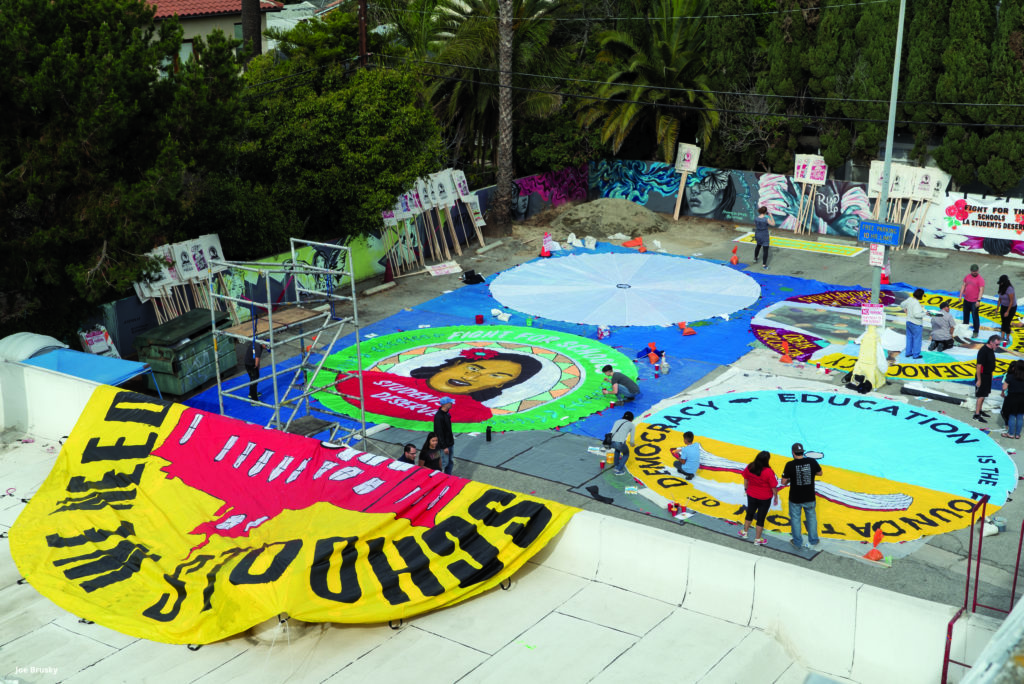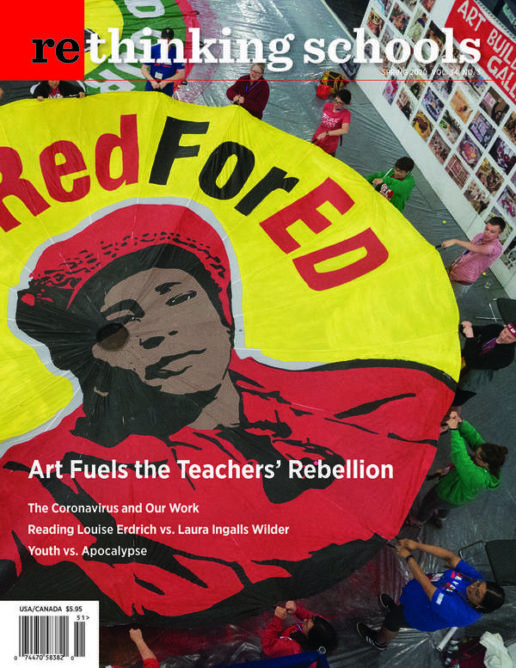What Can Art Do in the Perilous Present?
Illustrator: Joe Brusky

When working with educators and activists who have not had experience with the power of art in the struggle for justice, I often find myself answering questions about what art can really do in the face of injustice. Art can help visualize the problems we are fighting against, imagine a better future, and amplify our messages to a wide audience. In fact, visual and performing art have been at the core of some of the most successful campaigns for social justice in history.
We need ways of organizing that lift our spirits as we fight. Our days are now paced by a persistent, arrhythmic drumbeat of terrible news. In these times, I find that I have competing urges. The first is to misbehave more brazenly and bravely than I have in the past. I also feel compelled to re-center myself on a spiritual path as a result of anguish that I can only barely contain — but to do so in a way that stokes a fire of fierce love, which is a necessary fuel for resistance and for imagining a better, more just world. We need to create practices of resistance that also center on caring for ourselves and one another.
For the past couple of years in Milwaukee, Wisconsin, we have been building a collective effort to do just that through activist arts-based community events called art builds. Art builds provide spaces for movement-building for social justice. They create opportunities for activists and artists to work together to imagine a more just world. Art builds can be big or small — we have had art builds at national conventions with thousands of teacher activists and mini-art builds in classrooms with elementary and secondary students.
What Is an Art Build?
Art builds can take many forms and produce a variety of artifacts, but, according to my friend and collaborator Nicolas Lampert, they always center artmaking with community members in service to movements for justice. The size of builds can vary but I will describe what happens most often. Imagine a large space filled with people of all ages and walks of life talking about things that matter to them as they pitch in to trace and paint banners (including giant parachute banners), screen print signs and pennants, build puppets, and create other curiosities that will be deployed on the streets, in city hall, or in the state house to fight for a cause.
Our first art build took place in 2016, when Lampert invited David Solnit to be a speaker at the University of Wisconsin–Milwaukee (UWM). Solnit, a Bay Area-based carpenter, activist, and puppeteer, accepted the invitation and proposed that we also do an art build. His visit was a transformative experience for many of us in Milwaukee, and we have since hosted many art builds here as well as answered calls to do art builds in other cities. In January 2019, we reunited with Solnit in Oakland, California, to do an art build with teacher union activists as they prepared to embark on their historic and successful strike.
In 2018, Lampert, Paul Kjelland, Claudio Martinez, Josie Osborne, Joe Brusky, and I formed a collective called Art Build Workers. In 2019, we invited frequent collaborator Jeanette Arellano to join the group. Nicolas, Paul, Claudio, Josie, Jeanette, and I are the main artists and organizers of the group. Joe, who we call “the people’s photographer,” serves as video and photo documentarian and social media coordinator.
Through trial and error, we have developed a process for this work that has been refined over time. The following is a step-by-step list of the work.
- A community group, school, or organization reaches out to us because they are planning some sort of action for justice. In Milwaukee, frequent partners include Voces de la Frontera, an immigrant rights organization; Milwaukee Teachers’ Education Association and Milwaukee Public Schools educators; and youth from the local March for Our Lives and Youth Climate Action Team affiliates. In the past couple of years, we have begun working closely with the National Education Association (NEA) and local teacher unions to support education activism in other cities across the country.
- We ask community partners for relevant themes and slogans, from which we create proposed designs. We also reach out to local artists to be sure to include diverse voices. In Milwaukee, we work with an affiliation of artists called Voces de los Artistas, which formed in support of art builds and other social justice actions. When we partner with NEA we broaden our network through union members’ contacts to connect with artists in other cities.
- We share the proposed designs with our partners, who have the final say on content. Because they are the people closest to the action, partners respond to the designs, and then we make changes — or drop some altogether — according to their wishes.
- We reserve space and schedule a build, simultaneously putting word out via social media with our community partners. Originally, we rented a space above a brewery. Now we have access to spaces on the campus of UWM, which was made possible through negotiations with the dean of the Peck School of the Arts. The space is paid for through grants and other fundraising efforts.
- We transform the space by covering everything with tarps and organizing workstations that include areas for banner tracing and painting, screen printing, sign and puppet construction, children’s activities, food, and more.
- We work collectively with our community partners and hundreds of volunteers for as long as it takes to create the art they need for an action.
- We join our partners in the streets to use the art to create change.
What Do Art Builds Do?
The Art Build Workers developed the following list of what art builds do while on a ride from Milwaukee to Minneapolis, where we conducted a huge art build at the NEA’s Conference on Racial and Social Justice. Our team agreed that art builds should accomplish the following:
- Provide a creative entry point for community activist groups and their organizing efforts.
- Honor intersectionality of movements and build coalitions.
- Create an intergenerational space that honors a multiplicity of voices.
- Create a space for healing and nurturing the soul in a time when people are hurting.
- Invite artists to create work in support of movements for social justice.
- Generate social media attention that promotes the upcoming action, creates buy-in from a wide swath of community members, and captures history.
- Visualize the message and attract the news media to amplify it.
- Contribute to what Occupy Wall Street activist and scholar Yates McKee called a “movement imaginary,” a collective space in which to collectively imagine a more just world and bring joy to social justice work.
Movement Building: Notes on Art Build Culture
Not only do art builds create graphic images of protest, but we also create a commons — a mutually constructed cultural space in which we imagine and visualize the world in which we want to live. In his book Globalize Liberation: How to Uproot the System and Build a Better World, Solnit called this sort of space a “laboratory of resistance.” Making a collective space has proved to be critical in a time when many people are feeling overwhelmed by the drumbeat of bad news. This aspect of the art build movement speaks to the spiritual needs we art builders and others experience as we face and confront injustice.
Art builds craft community in the making phase as well as in the streets, where the art helps create cohesion and a sense of purpose among participants in a demonstration. The art invites playfulness and a joyful approach to social justice work, which is important to maintaining momentum over the long haul.
Relatedly, making artwork for art builds has had a positive effect. As Art Build Workers’ Jeanette Arellano testified, “Before you invited me to join in this work, I didn’t know art could be this powerful. I left art school feeling really depressed. Art builds have given me a new perspective on being an artist.” Designer Claudio Martinez echoed Jeanette’s sentiments when he beamed about the way making art for movements feels relative to his day job as a graphic designer. I join them in feeling a renewed excitement about being an artist because of my involvement with the art build movement. Art builds give artists a home within a community of other cultural producers who share their values.
Art builds also have an impact on the wider culture. The artwork visualizes social justice messages and attracts media attention to amplify our messages. According to Catherine Flood and Gavin Grindon, work of the type made through art builds can be thought of as disobedient objects. They claim:
Disobedient objects have a history as long as social struggle itself. Ordinary people have always used them to exert counterpower, and object-making has long been a part of social movement cultures alongside music and performance.
Through designing and working with others to create disobedient objects, artists can contribute in ways that amplify messages, ensnare the media, and ensure that our stories are shared with multitudes.
How Are Art and Education Connected?
As teachers who have experienced the ravages of neoliberal education reforms and racist systems of oppression in schools, we can often find ourselves emotionally drained. It is time for us to turn sorrow and rage into action, and art can help.
In the midst of the chaos that has become increasingly and dangerously normalized, activist art has been my lifeboat. Helping to create spaces where a movement imagination flourishes has given me a place to be among artists, teachers, and other community members who are creating a collective of care. It seems like art building is the only thing I can do right now to keep my head above these troubled waters. Art builds, for me, are a spiritual, artistic, and research practice that are at once a powerful and productive way to misbehave and a compelling form of spiritual practice. I invite you to join us.
A version of this article first appeared in Studies in Art Education. Reprinted with permission from the National Art Education Association, www.arteducators.org.

